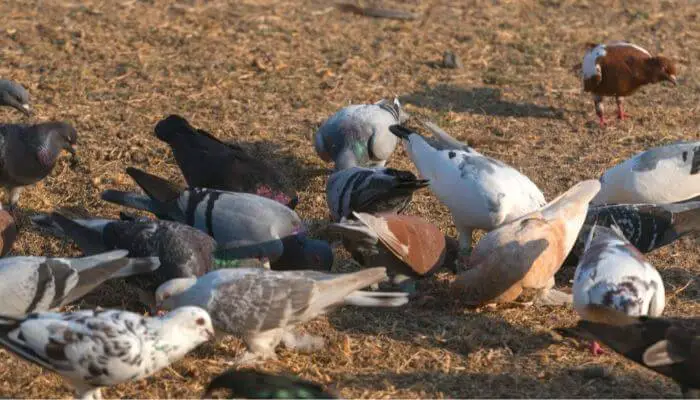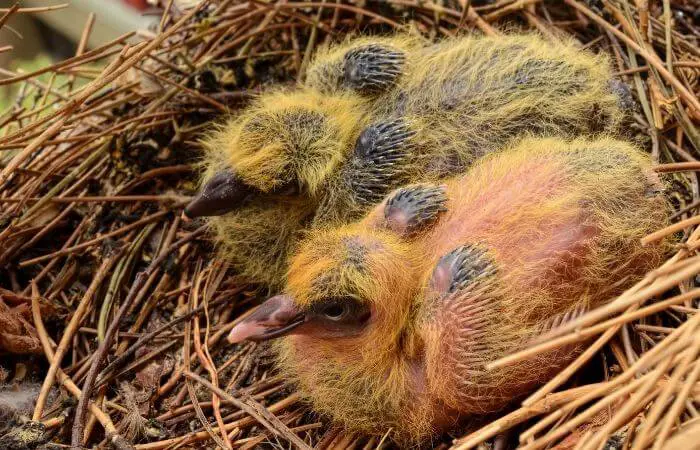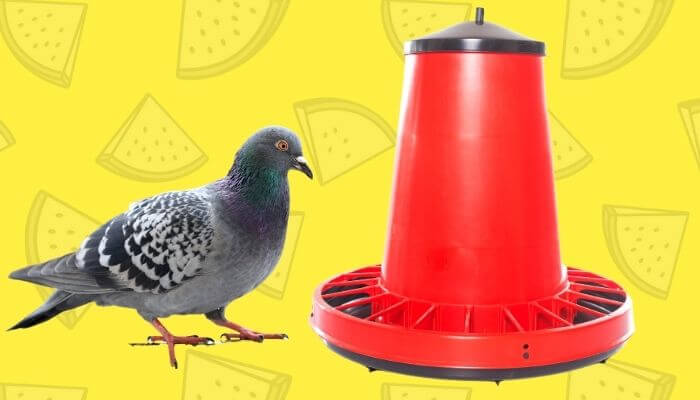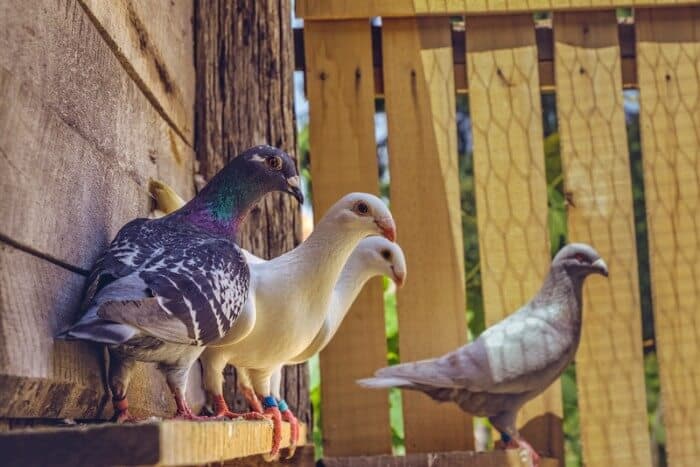Pigeon farming can be highly profitable.
A few good breeding pairs can quickly turn into a solid business.
In fact just 5 breeding pairs can produce up to 400 pigeons in less than 2 years, so providing you have the facilities to accommodate and feed them, there is little holding you back from making a success of this type of business.
If you simply want to get into pigeon farming as a hobby it is easy to keep your operations as small scale as you can handle too.
Why Get Into Pigeon Farming?
Pigeon farming is a profession that is centuries old, there is evidence that pigeon farms existed as long ago as 200BC.
To this day pigeon farming is a viable business model which is very easy to scale and make a good living from.
Here are four reasons why you should consider it:
1. Low Startup Costs
Starting a pigeon farm doesn’t need to cost an arm and a leg to get into.
The main thing you need is a pigeon loft/coop that can accommodate a decent number of pigeons, this will be your biggest expense.
If you buy a prefabricated one then you can spend up to $2,000 or more on this, however if you build a pigeon coop yourself then a good size coop can be attained for little more than $100.
In addition to this you also need to factor in things including pigeon food and nesting materials.

The average-sized pigeon requires approximately 30grams of seed mix per day If you are starting out with 5 breeding pairs then you need 300 grams of feed a day or 9kg of feed per month.
Depending on where you get your feed from you can easily get 20kg bags for less than $25.
So that’s an investment of roughly $10 a month on food, however be aware that food costs will quickly escalate as your pigeon numbers increase.
It is also possible to feed your pigeons for next to nothing…if you allow your pigeons to fly freely they will happily source their own food from nature. Whether or not this is advisable depends on where you live, if you live in a rural area than this is a good idea, however if you live in an urban setting it is not advisable as the dirty food they scavenge off the streets will negatively impact the quality of the pigeon meat you farm.
When you are first starting out nesting materials can usually be sourced from the land around you, sticks, pine needles, leaves and straw can work well and you should be able to source these for nothing.
So total start-up costs for your first month as a pigeon farmer could be as low as follows (not including the cost of your initial pigeons):
| Startup Equipment | Price |
|---|---|
| Loft | $100 |
| Food | $10 |
| Nesting Materials | $0 |
| Total | $110 |
2. Can Be Highly Profitable
Wood pigeon can sell for up to $8.00 and can cost as little as $1.00 to raise.
Of course profitability depends on how you scale your pigeon farm and where and who you sell the meat to.
If all things are set up optimally and you do all the required labor yourself then it is conceivable to turn a $1,000 investment into $8,000 in less than a year.
Below is a rough guide of how much income you could expect to generate with different numbers of pigeons:
| Number of pigeons (breeding pairs) | Squabs per year | Estimated revenue* |
|---|---|---|
| 10 (5) | 80 | $640 |
| 50 (25) | 400 | $3,200 |
| 100 (50) | 800 | $6,400 |
| 200 (100) | 1600 | $12,800 |
| 400 (200) | 3200 | $25,600 |
| 800 (400) | 6400 | $51,200 |
*This figure is based on a sales price of $8 per squab. This can vary greatly depending on the quality and size of your squabs (more on that below) and who you sell your squabs to.
If you sell them wholesale to a large store you may get a lower price however if you sell them direct to consumers you could more than double that price.
Be aware that selling all of your squabs direct to consumer will require significant marketing investment to make customers aware of your business, whereas selling wholesale only requires one or two good connections so doesn’t require much marketing spend.
The ideal scenario is you establish a wholesale deal initially while also selling squabs direct to consumer, as your B2C business grows and becomes more profitable you can slowly scale back the wholesale side of the business.
3. Easy To Scale
Pigeons are prolific breeders, providing they have a comfortable safe place to nest and a good food and water supply they will produce offspring..and plenty of them.
A breeding pair can produce up to 16 baby pigeons a year!
Providing you ensure that you have sufficient loft space to accommodate your growing brood, scaling up can be done very rapidly.
4. Multiple Ways To Monetise
The main way pigeon farms make money is by selling their pigeon squabs for meat.
However there are other ways you can monetise this business too:
- Sell the feathers.
- Open a pigeon petting zoo.
- Start a separate coop where you breed pigeons specifically for racing.
- Sell the droppings as high-quality fertilizer.
Selling feathers and pigeon droppings aren’t going to bring in big money but over time if done at scale the revenue that this passive pigeon income can make can be considerable.
Depending on where you are pigeon petting zoos can be very popular with local schools.
High-quality racing pigeons with champion fliers in their bloodline can sell for $200-$300+ so if you have the capital to invest in some champion fliers this can be very lucrative.
How To Start A Business Farming Pigeons
To start a business farming pigeons you need a number of things, first you need sufficient space to farm them in, then you need a loft, pigeon feed and of course, most importantly, pigeons!
What You Need:
The four things you need to start your pigeon farming business are pigeons (of course!), feed, space for them and a loft or coop to keep them in.
1. Suitable Pigeons
Choosing the right breed of pigeon can have a big impact on the overall proftability of your pigeon farm.
Bigger pigeons will sell for more as they have more meat on them.
When it comes to pigeon meat squabs (baby pigeons) will fetch the best price as their meat is softest.

Squabs should be sold for meat at about 3-4 weeks old, so you want to select a breed that is capable of producing the biggest 3-4 week old squabs in order to get the best price.
Below are some suitable breeds which produce large squabs ideal for meat production:
| Breed | 3 Week Old Squab Max Weight |
| French Mondain | 600g |
| Giant Runt | 600g |
| King Pigeons | 550g |
| Red Carneau | 500g |
| Giant Homers | 450g |
2. Feed
Good quality pigeon feed is essential for keeping your pigeons healthy while allowing the squabs to grow well and reach their potential so you can sell them at the best price.
Your pigeon feed should consist of around 16% protein, most premixed feeds will do this and will provide them with a well-balanced diet.
Below is a rough guide of how much you could expect to spend on food per month if you are exculsively buying pre-mixed seed.
| Number Of Pigeons (Breeding Pairs) | Approx. Feed/Month | Approx. Cost/month |
|---|---|---|
| 10 (5) | 9kg | $10 |
| 50 (25) | 45kg | $50 |
| 100 (50) | 90kg | $100 |
| 200 (100) | 180kg | $200 |
| 400 (200) | 360kg | $400 |
| 800 (400) | 720kg | $800 |
The average-sized pigeon requires approximately 30grams of seed mix per day, if your pigeons are bigger they will eat more, if they are smaller they will be cheaper to feed.
When it comes to feeding your pigeons this can be done very easily by using a pigeon feeder like the one shown below. Simply fill it up with seed and your birds will eat from the tray which will automatically refill as the seed is eaten.

You can reduce the cost of feeding your pigeons by mixing your own feed for them.
Pigeon feed is typically made up of things including oats, peas, corn, millet, barley, flaxseed popcorn and vetch. It is also worth adding things like lime, oyster shells and green vegetables into the feed to keep them in good condition.
Buying each of these individually in bulk can save you a lot of money on buying pre-mixed feed in the long run.
More info on making your own pigeon feed can be found here.
3. Space
You don’t have to have a huge amount of space to start farming pigeons.
Pigeons can be farmed on rooftops, in backyards even on balconies.
Of course the more limited your space is the harder it will be to scale your business up.
Ideally you need roughly 4 sq feet of space for every breeding pair of pigeons you have.
Below is a rough idea of the amount of space you’ll need depending on the number of pigeons you plan to have.
| Number of pigeons (breeding pairs) | Square Ft* |
|---|---|
| 10 (5) | 30 |
| 50 (25) | 150 |
| 100 (50) | 300 |
| 200 (100) | 600 |
| 400 (200) | 1200 |
| 800 (400) | 2400 |
*Based on 3sq ft per breeding pair. Smaller breeds will require less room, larger breeds may require more.
Ideally all pigeons should be reachable so the nesting spots in your loft shouldn’t exceed 6ft.
As you can see the need for space rapidly escalates as pigeon numbers multiply.
4. Pigeon Lofts
Ensuring that your pigeons have a safe, comfortable place to nest in is key to running a profitable pigeon farm.
Whether you buy a pigeon loft or make one yourself there are a few important things that you should ensure your pigeon loft does.
Face the loft towards the sun. Allowing sunlight directly into the loft will help keep the loft dry and will kill harmful bacteria.
Make sure the loft is well ventilated, mesh windows are ideal as it allows air to flow freely in and out, helping to keep your pigeons healthier.

Make sure it is sheltered from the rain, if you use mesh windows put an awning over them to prevent rain getting in.
You should also slightly elevate the loft (put it on a couple of bricks) to prevent water damage during the wet months.
One of the key things with managing pigeons is to keep their loft clean. Dirty lofts lead to diseases that can make your pigeons ill, may kill the squabs and can also be expensive to treat.
It is therefore important to keep the loft as clean as possible so that your squabs are healthy and fetch the best price and your coop stays as profitable as possible.
While some pigeon farmers suggest that one thorough clean of the loft every month is sufficient we recommend you clean the coop at least once a week, preferably twice to keep nesting boxes free of pigeon guano.
Breeding Your Pigeons
The success of your pigeon farm depends on your ability to produce and sell good quality squabs.
Below are a three tips which will help you breed healthy pigeons at a good rate:
1. Give Them Privacy
Providing breeding pairs with a covered box to nest and breed in will help them feel safer and more secure which means they are likely to settle down and start breeding far quicker.
2. Provide Good Quality Nesting Materials
Nesting materials come in all shapes and sizes, pigeons will even make do with a few twigs if needs be.
However to make them as comfortable as possible we recommend using tobacco stalks as they are both comfortable to sit on and are anti-parasitic so will help keep your pigeons healthy.
3. Feed Them Well
Because pigeon food is one of your main outgoings when running a pigeon farm it can be tempting to avoid buying premium seed mixes in favour of cheap ones that will cut into your profits less.
Doing this is not advisable because they may miss out on vital nutrients in cheap mixes which will reduce health and make them less ready and willing to mate, lay eggs and rear squabs.
Instead for the most cost effective solution we recommend (as already mentioned) that you mix your own seed batches so that you can be confident your pigeons are getting everything they need for optimal breeding without having to pay a premium for it.
So there you have it, if you take all this advice on board we are confident you can make a success out of pigeon farming, while it has its ups and downs pigeon farming can be a very rewarding business or a fun little way to make some extra income in your spare time.
